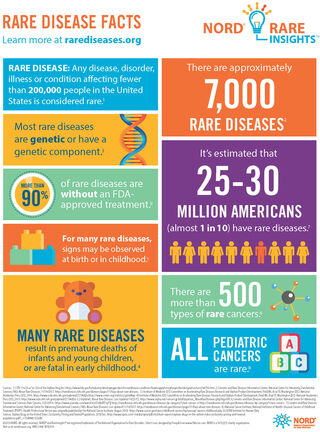Bias
Why Is the Stigma of Rare Disease So Common?
A new study finds that people with rare diseases face many levels of stigma.
Posted April 29, 2021 Reviewed by Lybi Ma
Key points
- Some 300 million people worldwide have a rare disease. In the U.S., any disease affecting fewer than 200,000 people each year is considered rare.
- A new study finds that people with rare disorders frequently experience structural, interpersonal, and felt stigma.
- People with rare diseases were blamed, invalidated, or avoided, and faced accessibility barriers.
- Systemic change is needed to reduce access barriers and lack of information about rare diseases.
By Marla Munro and Kathleen Bogart
Globally, there are more than 300 million people who have one of the 7,000 known rare diseases (Nguengang Wakap et al., 2020). In the United States, any disease affecting fewer than 200,000 people per year is considered rare. People with rare diseases experience many of the same challenges who those with more common chronic illnesses deal with, but they also face additional barriers and stigma due to how rare their conditions are. Some of these unique challenges include having significantly delayed diagnosis (averaging seven to nine years), receiving multiple misdiagnoses, and lacking access to information about or treatments for their conditions (von der Lippe et al., 2017; Zhu et al., 2017).
People with rare diseases often face social and psychological challenges, such as isolation because they do not know anyone with their disease (Anderson et al., 2019; Bryson et al., 2021) and a higher risk of anxiety and depression (Bogart & Irvin, 2017). In a new study published last week, we found that people with rare diseases also face significant stigma and ableism (Munro, Cook, & Bogart, 2021).

Stigma occurs when a certain attribute or identity is deemed socially unacceptable or inferior by people with power, leading to structural and interpersonal discrimination (Parker & Aggleton, 2003). This discrimination contributes to social inequity and can negatively impact those with the stigmatized trait. Previous research studies have noted that stigma can be a common issue for people with rare diseases (von der Lippe et al., 2017), but this topic has not been explored in-depth across a large variety of rare diseases. In our new study, we catalog the stigma experiences that people with rare diseases face (Munro et al., 2021). Our study included 384 participants with 178 different rare diseases. The most frequently represented rare diseases were Ehler-Danlos syndrome, mast cell activation disorder, and narcolepsy. We conducted a qualitative analysis of responses to an open-ended survey question about rare disease challenges. We found that structural, interpersonal, and felt stigma can have pervasive impacts on the daily lives of people with rare diseases.
Structural Stigma
Many of our participants wrote about experiencing structural stigma within societal structures such as healthcare settings, workplaces, and educational institutions. They were frustrated by their healthcare providers’ lack of knowledge about rare diseases and felt invalidated when their providers dismissed their symptoms as being “in their heads.” Employers and schools often refused to accommodate their access needs, which sometimes led to participants having to prematurely leave jobs or degree programs. Additionally, an overall lack of accessibility was noted by participants who faced difficulties related to dietary restrictions, mobility, energy levels, and sensory sensitivities.
Interpersonal Stigma
Interpersonal stigma occurs in one’s interactions with other individuals. The most common issues that came up were a lack of perceived social support, invalidation or lack of understanding from others, and capitalist norms. Participants were frustrated when their loved ones did not try to understand their rare disease, leading to them providing inappropriate or insufficient support. Support from other people with rare diseases was hard to come by because of how rare these conditions are, though some participants found supportive online communities of people with their rare diseases. Some participants wrote about feeling misunderstood and judged by others who viewed their rare diseases as self-inflicted or something they were making up to get attention. Additionally, capitalist norms of productivity and independence led participants to feel inadequate, and they struggled with separating their occupation from their personal identity.
Felt Stigma
Felt stigma refers to the ways people make sense of the stigma they experience by turning those negative stereotypes inward and/or living with the expectation that they are going to experience discrimination from others. Some participants, especially those with more visible symptoms, felt shame about how they looked, acted, or communicated because of their rare disease. This sometimes was connected with lower self-esteem. Another theme that we noted was participants feeling the need to “pass” or be seen as able-bodied to avoid stigma. Some felt it was easier to hide the symptoms or severity of their rare disease to make others more comfortable.
A Call for Social and Systemic Change
Overall, stigma had a notable impact on our participants and further exacerbated the challenges that come with having a chronic illness. Our results indicate that more education about rare diseases is needed for both healthcare providers and the general public. Additionally, increasing accessibility across all domains of society would improve the quality of life for people with rare diseases.
On an individual level, combatting stigma and promoting greater accessibility can look like checking on friends’ dietary and sensory needs when inviting them to an event, not providing unwanted advice about possible rare disease remedies, and recognizing everyone’s capacity is different.
While individuals and smaller organizations or groups can make positive contributions to this effort, systemic change is urgently needed to fully address the issue of rare disease-related stigma. In our opinion, at its core, rare disease-related stigma is based in ableism, which relies on the ideology of individualism, a hierarchy of what bodies are “best,” and the need for people to prove their worth by contributing “productive,” full-time labor (Pimentel & Monteleone, 2019). It is crucial to recognize the impacts of ableism and other systems of oppression on people with rare diseases while working towards dismantling those systems through community organizing and activism.
Marla Munro is a Ph.D. student in counseling psychology at the University of Houston and an alumna of Dr. Bogart’s lab.
References
Anderson, R., Walburn, J., & Morgan, M. (2019). Experiences of stigma over the lifetime of people with xeroderma pigmentosum: A qualitative interview study in the United Kingdom. Journal of Health Psychology, 24(14), 2031–2041. https://doi.org/10.1177/1359105317714643
Bogart, K. R., & Irvin, V.L. (2017). Health-related quality of life among adults with diverse rare disorders. Orphanet Journal of Rare Diseases, 12(177). doi: 10.1186/s13023-017-0730-1
Bryson, B., Bogart, K. R., Atwood, M., Fraser, K., Locke, T., Pugh, K., & Zerrouk, M. (2021). Navigating the unknown: A content analysis of the unique challenges faced by adults with rare diseases. Journal of Health Psychology, 26(5), 623–635. https://doi.org/10.1177/1359105319828150
Munro, M., Cook, A. M., & Bogart, K. R. (2021). An inductive qualitative content analysis of stigma experienced by people with rare diseases. Psychology and Health. https://doi.org/10.1080/08870446.2021.1912344
Nguengang Wakap, S., Lambert, D. M., Olry, A., Rodwell, C., Gueydan, C., Lanneau, V., Murphy, D., Le Cam, Y., & Rath, A. (2020). Estimating cumulative point prevalence of rare diseases: Analysis of the Orphanet database. European Journal of Human Genetics, 28(2), 165–173. https://doi.org/10.1038/s41431-019-0508-0
Parker, R., & Aggleton, P. (2003). HIV and AIDS-related stigma and discrimination: A conceptual framework and implications for action. Social Science & Medicine, 57(1), 13–24. https://doi. org/10.1016/S0277-9536(02)00304-0
Pimentel, M. S., & Monteleone, R. (2019). A privileged bodymind: The entanglement of ableism and capitalism. International Journal of Economic Development, 12(1), 63–81.
von der Lippe, C., Diesen, P., & Feragen, K. (2017). Living with a rare disorder: A systematic review of the qualitative literature. Molecular Genetics & Genomic Medicine, 5(6), 758–773. https://doi.org/10.1002/mgg3.315
Zhu, X., Smith, R., & Parrott, R. (2017). Living with a rare health condition: The influence of a support community and public stigma on communication, stress, and available support. Journal of Applied Communication Research, 45(2), 179–198. https://doi.org/10.1080/00909882. 2017.1288292


